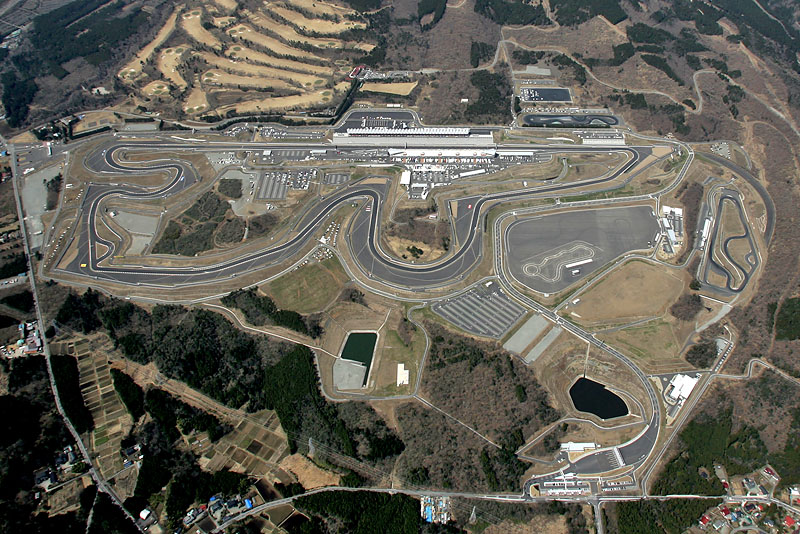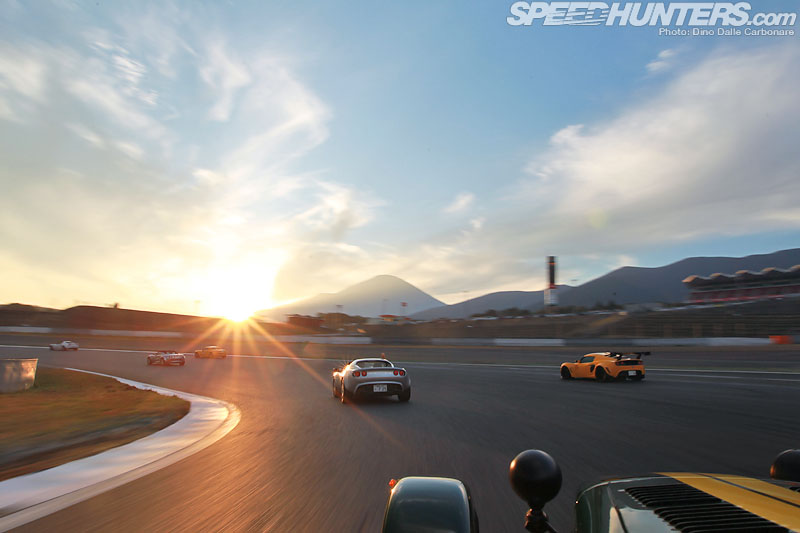
If there is one track that really qualifies as a Temple of Speed, it has to be Fuji Speedway. It might not have the long history of some of the legendary race circuits we have featured so far like Brooklands and Autodromo Nazionale Monza, but since its opening in December 1965 it has held an impressive variety of racing, including F1.

Fuji Speedway, or Fisco as it was called back in the day, has helped mature so many different forms of Japanese racing series…

…helping create a few legends along the way. This is where the Skyline 2000 GT-R proved itself and quickly grew to become the king of the Japanese GT racers.

Located in Oyama – at the feet of Mt. Fuji in Shizuoka-ken, from where it borrows its name from – Fuji Speedway was initially supposed to be a 2.5 mile (4 km) Nascar-type banked oval. During construction however, the funds available for construction soon began running out and after the first banked turn had been erected it was decided to convert the layout into a more conventional circuit course.

Despite a complex series of in-field corners the 2.7 mile (4,3 km) Fuji Speedway turned out to be one of the fastest circuits in the world with an extremely long main straight that spanned almost a mile (1.5 km). Here is an image from 1966 and the Fuji 200 Indy race that was won by Jackie Stewart.

The high speeds that were achieved made it an extremely technical track and at the same time very dangerous…

…especially the banked turn. Despite aerodynamics coming more into play at the end of the sixties, higher top speeds and more powerful open wheel racers, seen here in this image from 1969, did make the banking quite tricky.

On one of my recent visits to Fuji I decided to take a closer look of the remaining parts of the banking…

…that is overlooking the tight Fuji Short Course on the very far right hand side of the grounds.

It’s great to see that during the track renovations from 2003 to 2005 it was decided to keep this historical part of the track intact, and keep access to it open. Once you arrive at the opening in the fence…

…you are greeted with a warning sign telling you to watch your step, as the banking is quite slippery (due to its inclination).

It’s hard to get the full sense of the actual angle, but believe me it requires some serious effort…

…and grippy shoes to climb up to the top.

While up there, on the very edge of where old race cars used to zoom past at almost top speed, you can’t help but ponder over how the cars, motorsports and everything that revolves around them has changed so much. It might have gotten a lot safer over the years, for both the drivers and spectators…

…but it’s hard not to admire the courage some of the drivers had.

Back in the mid sixties the whole Japanese motorsport scene was still very much in its infancy and one of the main events back then were endurance races like the Fuji 1000 km race. Above is a picture taken during the beginning of the 1967 race…

…which was won by a Toyota 2000GT.

At the end of 1968 Fuji hosted the Fuji 200 mile Can-Am race…

…where the track was run in counter clockwise direction.

This was probably due to the dangerous high-speed entry onto the banking…

…an area of the layout that caused the highest number of fatalities.

Here is a look at the in-field hairpin that still exists today, used by the D1-GP drift series as the main judged corner.

Fuji was also the venue for the Nihon GP races where prototypes from various manufacturers like the Nissan R380 & R381, the Toyota 7 and Lola T70 fought hard against each other. This is where top Japanese drivers like Takahashi Kunimitsu, Masahiro Hasemi and Kurosawa Motoharu showed the world what they could do.

This is an image of the warm-up lap of the 1971 Nihon GP. Notice the S30 Fairlady Z pace car! Three years later, following a big accident where drivers Hiroshi Kazato and Seiichi Suzuki lost their lives on the banking, the track layout was modified, cutting out the whole top section of the track and introducing a tight right hand corner at the end of the straight,t to slow cars down.

Formula 1 didn’t hit Fuji Speedway until 1976, marking the first ever Japan F1 race. In terrible rainy conditions…

…Mario Andretti in the number 5 Ford-powered Lotus took the win but James Hunt grabbed enough points from Nicky Lauda (who retired) to win the championship.

1976 was also the year that Tyrrell introduced the P34, the famous 6-wheeler F1 car. Here is a shot of Jody Scheckter at the wheel.

Fuji continued to be a popular track for a variety of series which included a lot of endurance racing where the little Nissan Sunny shined.

By far one of the most exciting forms of motorsport that was held at Fuji was during the eighties with Group 5…

…later replaced by Group C racing, the era of extreme and highly powerful prototypes. Here is an image of the Hasemi-Tomica DR30 Gr.C doing what it did best, spitting big flames on every downshift!

From 1982 to 1988 the Fuji 1000 km became part of the World Sportscar Championship where cars like the Porsche 956 fought against the best the All Japan Sport Prototype Championship had to offer.

The Rothmans 956s won the first three races, the above number 2 car of Derek Bell and Stefan Bellof reigning victorious in the 1983 race. WSPC racing ended in 1988…

…but the 1000 km race continued until 1992 as part of the All Japan Sport Prototype Championship.

Throughout the early nineties, Fuji was a main venue for the Japanese Touring Car Championship where Gr.A racers like the legendary R32 Skyline GT-Rs fought it out in some of the best racing Japan had to offer at the time. In 1994 the All-Japan Touring Car Championship (JGTC) was introduced, combining the by then defunct Group C All Japan Sport Prototype Championship and the Gr.A touring cars.

In 2000 Toyota Motor Company purchased Fuji Speedway with plans to modernize the track and create a hub for international racing in Japan, the main focus to bring F1 back to Fuji (which was regularly held in Suzuka). In 2003 the track was closed down and the work began, Toyota brought in Herman Tilke to come up with a modern design that would mix the unmistakable corners of the old Fuji with a more modern feel and plenty of safety.

The brand new and improved Fuji Speedway reopened in April 2005 and I remember heading there a week or so after to check out a big tuner Grand Prix that was being held there with all the top tuning shops in Japan. That included the late Tanabe-san from Power House Amuse who you can see in the above picture crossing the pit lane in his green overalls.

Unlike a lot of other international top-level tracks Fuji never turned down drifting, embracing this new form of motorsport and allowing the D1 series to run one or two rounds there each season. Furthermore Fuji Speedway also offers a small separate drift track inside its grounds as well as a smaller “Short track” which is used for track day events and driving courses.

The Fuji Speedway NS4 license system allows enthusiasts the chance to drive on track when there are no big events being held. Drop by during a weekday and you are guaranteed to see a paddock full of cars of every type, their owners there to enjoy driving on the limit in total safety.

On top of all that history and great number of race events, Fuji Speedway…

…is the venue for the yearly Nismo Festival and Toyota Motorsport Festival (now called Gazoo Racing Festival)…

…as well as the Japan Lotus Day we checked out last year.

Located just over an hour from central Tokyo it’s no surprise to see what Fuji Speedway has over the last (almost) four decades evolved into. It’s a center for a great deal of Japan’s varied motorsports scene and a great place for enthusiasts…

…to enjoy their love for cars at, be it attending races, events, meetings or track days.
Temple of Speed features on Speedhunters
All historic images courtesy of Fuji Speedway
-Dino Dalle Carbonare








Thanks for sharing a lovely post on a great track! Btw, the pace car in the 1971 Nihon GP is actually a Datsun Fairlady Z, possibly even a Z432...
I enjoyed reading about FSW's history. It was quite interesting
@datsunsss Yes spotted that, fixed the mistake:)
@datsunsss BTW awesome blog datsunsss!!
@speedhunters_dino Thank you Dino! Appreciate the kind words...
Toyota should have modify that legendary track into a roval, like it was intended to be. If it does, they would invite NASCAR to race there!
You have failed to mention that current Fuji sucks, just look at 2007-08 Japanese GP. It is just another Tilkedrome.
Very nice post with stunning photos!
Very nice post with stunning photos!
Very nice post with stunning photos!
Very nice post with stunning photos!
Love it
Love it
Love it
Love it
Great post!
Should credit the old photos though.
Great post!
Should credit the old photos though.
Great post!
Should credit the old photos though.
Great post!
Should credit the old photos though.
Great post!
Should credit the old photos though.
Great post!
Should credit the old photos though.
Great post!
Should credit the old photos though.
Great post!
Should credit the old photos though.
great post
Wow. Another great Temple of Speed by you guys!
why we haven't motorsports complex like that in france... thanks to speedhunters for the report!
Fantastic feature. What a great history. I am happy to see fuji continuing it's success. I wonder if F1 will ever return? Fuji is a track that definitely has "soul". Definitely a bucket list destination.
Yeah, he made it so boring that Toyota pulled out of F1 along with Fuji Speedway in 2009! Man, if only Fuji turned into the second Daytona Speedway... @dujedcv
excellent! nice post!
really enjoyed that article Dino. Thanks
Excellent write up Dino!
Great to see the history of the place.
Awesome write up! We need more of these Temple of Speed articles! Great work Dino.
Herman Tilke only make shit in the circuits.
@Benigmatica @dujedcv well anythings better than a NASCAR oval i guess...just sayin...
@Benigmatica @dujedcv well anythings better than a NASCAR oval i guess...just sayin...
Fantastic!
that was brilliant - thanks.